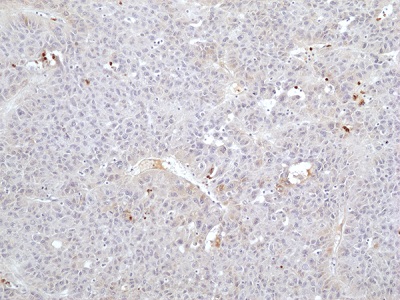
Immunohistochemical staining of formalin-fixed and paraffin-embedded human hepatocellular carcinoma (HCC) tissue sections using anti-FGL1 Rabbit Monoclonal Antibody (RM502) at 1:100 dilution, for 1hr at room temperature.
anti-FGL1 (human), Rabbit Monoclonal (RM502)
REV-31-1394-00
ApplicationsWestern Blot, ImmunoHistoChemistry
Product group Antibodies
TargetFGL1
Overview
- SupplierRevMAb Biosciences
- Product Nameanti-FGL1 (human), Rabbit Monoclonal (RM502)
- Delivery Days Customer10
- ApplicationsWestern Blot, ImmunoHistoChemistry
- CertificationResearch Use Only
- ClonalityMonoclonal
- Clone IDRM502
- Gene ID2267
- Target nameFGL1
- Target descriptionfibrinogen like 1
- Target synonymsHFREP1, HP-041, HPS, LFIRE-1, LFIRE1, fibrinogen-like protein 1, hepassocin, hepatocellular carcinoma-related sequence, hepatocyte-derived fibrinogen-related protein 1, liver fibrinogen-related protein 1
- HostRabbit
- IsotypeIgG
- Protein IDQ08830
- Protein NameFibrinogen-like protein 1
- Scientific DescriptionFGL1 (Fibrinogen-like protein 1, also called Hepatocyte-derived fibrinogen-related protein 1, HFREP-1 or Hepassocin) was initially identified as an overexpressed transcript in hepatocyte carcinoma and as a transcript enriched in regenerating liver. FGL1 is expressed at lower levels in brown and white adipose in the setting of liver injury. A low level expression of FGL1 is also observed in the pancreas. FGL1 is a 34kDa protein structurally similar to Angiopoietin-like factors 2, 3, 4 and 6, which regulate lipid metabolism and energy utilization. It was proposed that FGL1 is a member of an emerging group of proteins having potential roles in liver metabolism and liver regeneration. Recently, FGL1 has also been shown to be upregulated in human cancers and FGL1 is a major functional ligand of LAG-3. FGL1 interacts with LAG-3 in a MHC-II-independent manner and this interaction involves the FGL1 fibrinogen-like domain and the LAG-3 D1-D2 domain. FGL1-LAG-3 interaction blockade promotes tumor immunity by stimulating T cell expansion and activation. FGL1 forms two disulfide-linked homodimers and also higher molecular weight homooligomers that bind to LAG-3 much better than the dimeric forms. This binding to LAG-3 inhibits T cell responses. FGL1 is highly produced by human cancer cells, and elevated FGL1 in the plasma of cancer patients is associated with a poor prognosis and resistance to anti-PD-1/ B7-H1 therapy. - Recombinant Antibody. This antibody reacts to human FGL1. Isotype: Rabbit IgG. Immunogen: A peptide corresponding to the C-terminus of human FGL1. Applications: IHC, WB. FGL1 (Fibrinogen-like protein 1, also called Hepatocyte-derived fibrinogen-related protein 1, HFREP-1 or Hepassocin) was initially identified as an overexpressed transcript in hepatocyte carcinoma and as a transcript enriched in regenerating liver. FGL1 is expressed at lower levels in brown and white adipose in the setting of liver injury. A low level expression of FGL1 is also observed in the pancreas. FGL1 is a 34kDa protein structurally similar to Angiopoietin-like factors 2, 3, 4 and 6, which regulate lipid metabolism and energy utilization. It was proposed that FGL1 is a member of an emerging group of proteins having potential roles in liver metabolism and liver regeneration. Recently, FGL1 has also been shown to be upregulated in human cancers and FGL1 is a major functional ligand of LAG-3. FGL1 interacts with LAG-3 in a MHC-II-independent manner and this interaction involves the FGL1 fibrinogen-like domain and the LAG-3 D1-D2 domain. FGL1-LAG-3 interaction blockade promotes tumor immunity by stimulating T cell expansion and activation. FGL1 forms two disulfide-linked homodimers and also higher molecular weight homooligomers that bind to LAG-3 much better than the dimeric forms. This binding to LAG-3 inhibits T cell responses. FGL1 is highly produced by human cancer cells, and elevated FGL1 in the plasma of cancer patients is associated with a poor prognosis and resistance to anti-PD-1/ B7-H1 therapy.
- Storage Instruction-20°C
- UNSPSC12352203






